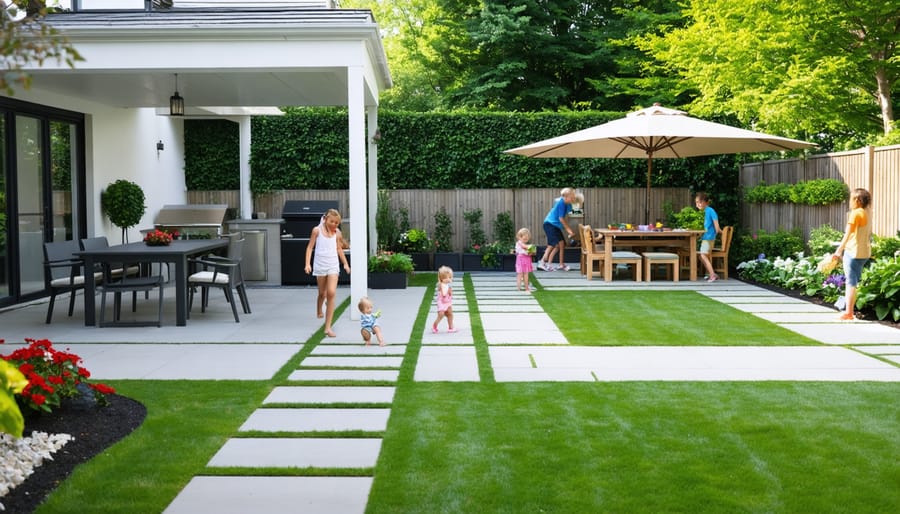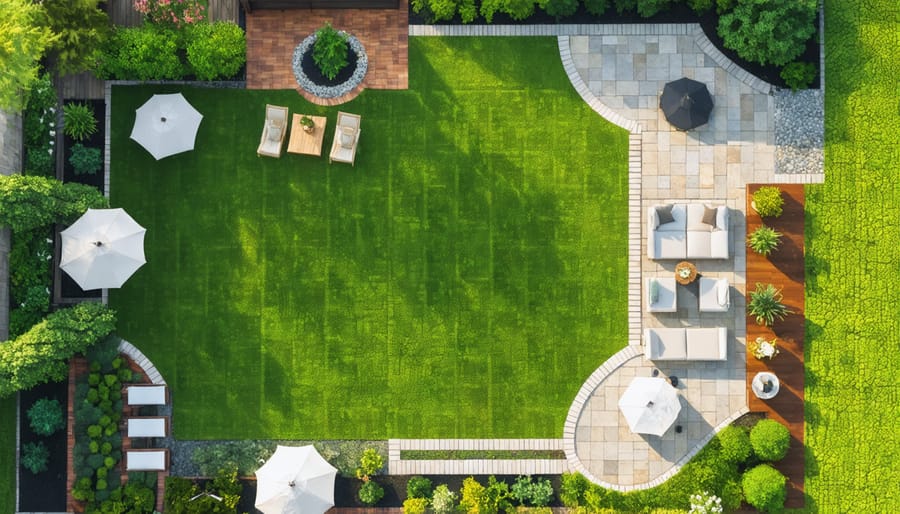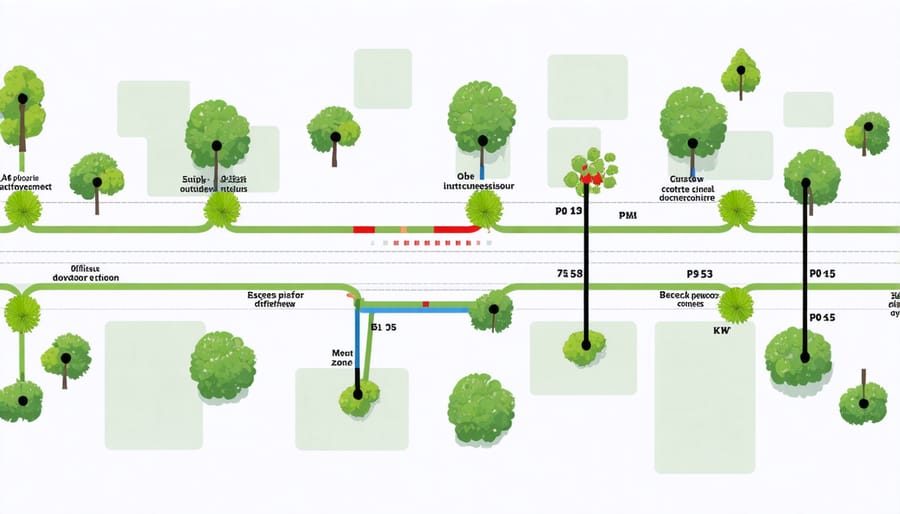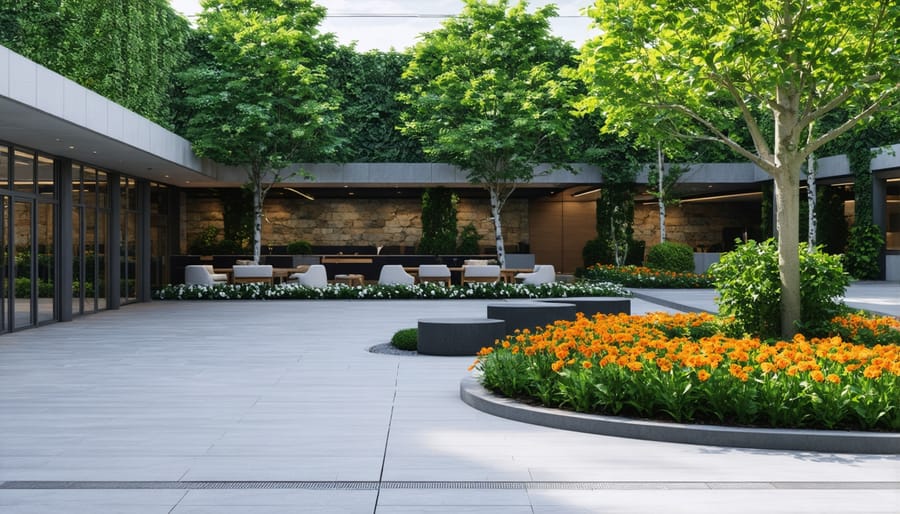Smart Space Planning: How to Zone Your Outdoor Areas for Maximum Enjoyment

Transform your outdoor space into purposeful zones that enhance both functionality and property value. Smart zoning divides your yard into distinct areas for recreation, entertainment, storage, and green spaces, creating a harmonious balance that maximizes every square foot. Whether you’re working with a compact urban yard or sprawling suburban property, strategic zone planning eliminates wasted space while maintaining essential pathways and sight lines.
Start by mapping your yard’s natural traffic patterns and identifying areas that receive optimal sunlight, shade, or protection from wind. These environmental factors naturally suggest ideal locations for specific activities – morning sun perfect for vegetable gardens, afternoon shade ideal for outdoor dining, and secluded corners well-suited for storage solutions. Consider how each zone flows into the next, ensuring smooth transitions between areas while maintaining privacy where needed.
Modern zoning approaches integrate storage seamlessly into the landscape, turning practical necessities into aesthetic features that complement your outdoor living spaces. This thoughtful organization creates a more enjoyable, efficient outdoor environment that serves multiple purposes while maintaining visual appeal.
Understanding Outdoor Zones: The Foundation of Smart Layout

Activity Zones
Creating distinct activity zones in your yard helps maximize functionality while maintaining harmony in your outdoor space. Start by designating specific areas for your outdoor entertainment space, including a dining area for family meals and gatherings. Establish quiet zones for relaxation, perhaps with comfortable seating and shade structures. For families with children, incorporate a dedicated play area with safety surfacing and age-appropriate equipment. Consider adding a garden zone for those who enjoy growing plants or vegetables. Keep these zones connected yet separate through thoughtful placement of pathways, landscaping elements, and strategic storage solutions. This organization creates natural flow while ensuring each area serves its intended purpose without overlapping or creating cluttered spaces.
Storage Zones
Every well-planned outdoor space needs dedicated areas for storing tools, equipment, and seasonal storage solutions. Consider designating a corner of your yard for a storage shed, positioning it where it’s easily accessible but doesn’t dominate the landscape. Place frequently used items like gardening tools near your garden beds, while storing bulkier equipment along the property’s perimeter. Create mini-zones within your storage area by grouping similar items together – lawn care equipment in one section, pool supplies in another, and seasonal decorations in a protected space. Remember to leave enough clearance around storage structures for easy access and maintenance. By thoughtfully planning these storage zones, you’ll maintain a clutter-free yard while keeping essential items within reach when needed.
Transition Zones
Transition zones act as natural buffers between different areas of your yard, helping to create a smooth flow from one space to another. These buffer areas can be as simple as a row of decorative plants or as elaborate as a winding pathway. Consider using a mix of low-growing shrubs and ornamental grasses to separate your storage shed from your entertainment area, or install stepping stones to create a gentle transition between your garden and play space. These zones not only improve the visual appeal of your yard but also serve practical purposes, such as reducing noise between areas and providing additional privacy. For maximum effectiveness, aim to make transition zones at least 3-5 feet wide, allowing enough space for both functional and aesthetic elements while maintaining easy access to all areas of your yard.
Creating Your Zoning Plan
Assessing Your Space
Before diving into your outdoor space transformation, take time to thoroughly evaluate your available area. Start by measuring the total square footage of your outdoor space, noting any existing features like trees, gardens, or permanent structures. Create a simple sketch of your yard, marking natural pathways, sunny and shaded areas, and drainage patterns.
Consider how you currently use different areas of your yard and what activities you’d like to accommodate. Are there spots that naturally lend themselves to specific purposes? For example, a level, sunny area might be perfect for a vegetable garden, while a shaded corner could become a cozy reading nook.
Pay attention to your property’s topography and any potential challenges like slopes or uneven ground. Note existing utilities, including underground pipes, electrical lines, or irrigation systems. These elements will influence your zoning decisions and help determine suitable locations for various activities.
Don’t forget to account for local climate patterns and seasonal changes. Understanding how sun exposure, wind patterns, and water flow affect different areas of your yard will help you make informed decisions about space allocation and ensure your outdoor zones remain functional year-round.
Mapping Traffic Flow
Analyzing traffic flow patterns in your outdoor space is crucial for creating functional and accessible zones. Start by identifying main entry points, such as doors, gates, and pathways that connect different areas of your property. Consider how family members and guests naturally move through the space during daily activities and special occasions.
Map out primary walking routes between frequently used areas like the back door to the garden, or from the driveway to the main entrance. These paths should be clear, direct, and wide enough for comfortable passage, typically 3-4 feet minimum. Create secondary pathways for less frequent but important connections, such as routes to utility areas or storage spaces.
Pay special attention to high-traffic zones where paths intersect or where multiple activities occur. These areas may need wider clearance or durable surfaces to withstand increased foot traffic. Remember to account for seasonal changes and maintenance access when planning your traffic flow patterns.

Integrating Storage Solutions
Incorporating storage solutions into your zoned outdoor space doesn’t mean sacrificing style for functionality. Strategic placement of sheds and storage units can actually enhance your yard’s organization while maintaining its visual appeal. Consider positioning a shed along property boundaries or against existing structures to maximize open areas for activities. Choose designs and materials that complement your home’s architecture – modern metal units work well with contemporary homes, while wooden sheds suit traditional landscapes.
For seamless integration, create a dedicated storage zone with attractive pathways leading to it. Surround storage structures with thoughtful landscaping, such as climbing vines or decorative shrubs, to soften their appearance. Multi-purpose solutions, like bench storage or deck boxes, can serve as both seating areas and storage spots in activity zones. Remember to check local zoning regulations before installation, as many areas have specific requirements for shed placement and size limitations.
Maximizing Zone Functionality
Multi-Purpose Design
Making the most of your outdoor space means creating versatile areas that adapt to your changing needs. Start by identifying zones that can serve multiple purposes throughout different seasons or times of day. For example, a patio area can function as an outdoor dining space during summer afternoons and transform into a cozy entertainment area with strategic outdoor lighting design for evening gatherings.
Consider incorporating movable elements like portable planters or modular furniture that can be easily rearranged to accommodate various activities. A flat, well-maintained lawn area can serve as a children’s play space during the day and convert to an outdoor movie viewing area at night. Storage solutions, such as decorative deck boxes or benches with hidden compartments, can help maintain the space’s flexibility while keeping necessary items close at hand.
When planning multi-purpose zones, focus on durable surfaces and weather-resistant materials that can withstand different uses. Include transitional spaces that flow naturally from one activity area to another, making it easy to adapt your outdoor living space as needed. Remember, the key to successful multi-purpose design is maintaining simplicity while maximizing functionality.

Weather Considerations
When planning your outdoor zones, it’s crucial to consider how weather patterns will affect each area throughout the year. Position seating areas where they’ll catch morning sun but offer afternoon shade during summer months. Create wind breaks using strategic plantings or decorative screens to protect gathering spaces from harsh winter winds.
Consider seasonal drainage patterns when designating activity zones. Locate storage sheds and play areas on slightly elevated ground to prevent water pooling during rainy seasons. If you live in a snowy climate, plan pathways between zones that are easy to clear and maintain during winter months.
Think about how sunlight shifts across your yard throughout the seasons. Summer entertainment zones benefit from natural shade, while vegetable gardens need full sun exposure. Installing retractable awnings or shade sails can help adjust to changing conditions. For year-round comfort, incorporate covered transitions between zones, allowing comfortable movement through your outdoor space regardless of weather.
Remember to choose weather-resistant materials for permanent fixtures and consider how different surfaces will perform in various weather conditions.
Maintenance Planning
Creating an easy-to-maintain zoning plan starts with thoughtful organization and regular upkeep schedules. Consider designating specific days for maintaining different zones, such as mowing lawns on weekends and pruning garden areas mid-week. Keep maintenance tools and equipment stored near the zones where they’ll be most frequently used to save time and effort.
Implement low-maintenance solutions like mulch pathways between zones to reduce weed growth and minimize upkeep. Choose hardy, native plants that require less attention and group plants with similar water needs together to streamline irrigation. Install automated systems where possible, such as timed sprinklers or motion-sensor lighting, to reduce daily maintenance tasks.
Keep a digital or physical maintenance log to track when different zones need attention. This helps prevent overlooking less frequently maintained areas and allows you to spot patterns in maintenance needs. Consider seasonal changes when planning maintenance schedules – some zones may require more attention during specific times of the year. Regular assessment of your zoning plan helps identify areas that may need adjustments to make maintenance more efficient over time.
Taking the time to properly zone your open space can transform your outdoor area from a chaotic catch-all into an organized, functional, and beautiful environment. By carefully planning your yard’s layout and incorporating dedicated zones for storage, recreation, and relaxation, you’re not just creating order – you’re enhancing your property’s value and your family’s quality of life.
Remember that successful zoning starts with assessing your specific needs and available space. Take inventory of your outdoor items, consider your family’s activities, and think about future requirements. Don’t be afraid to start small and expand your zoning plan gradually. Many homeowners find that tackling one zone at a time leads to better results than trying to reorganize everything at once.
As you begin your zoning project, keep local regulations in mind and consider consulting with neighbors who have successfully organized their outdoor spaces. Their experiences can provide valuable insights and inspiration. Document your progress with photos and measurements – this will help you stay motivated and make adjustments as needed.
Whether you’re installing a new shed, creating a garden sanctuary, or designating play areas for children, proper zoning will help you maximize every square foot of your outdoor space. Start your zoning journey today, and watch as your yard transforms into the organized, functional oasis you’ve always wanted.

